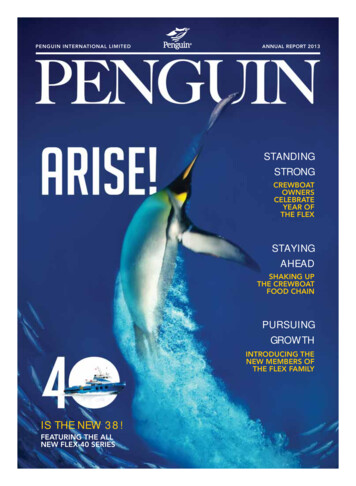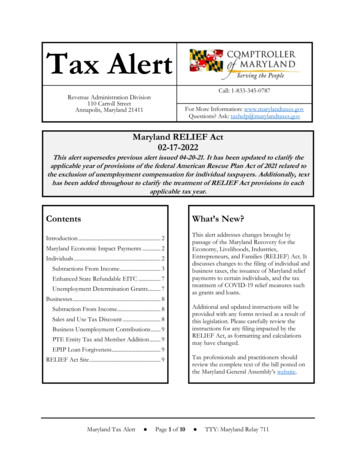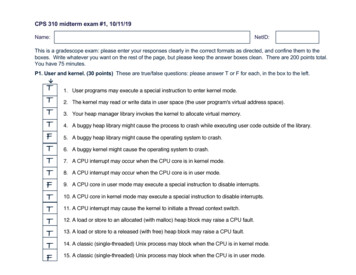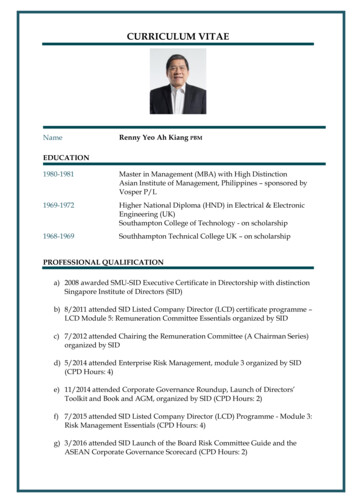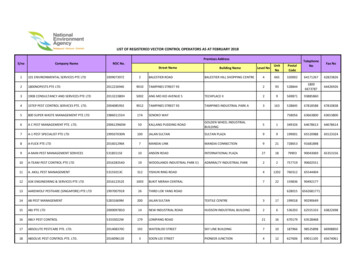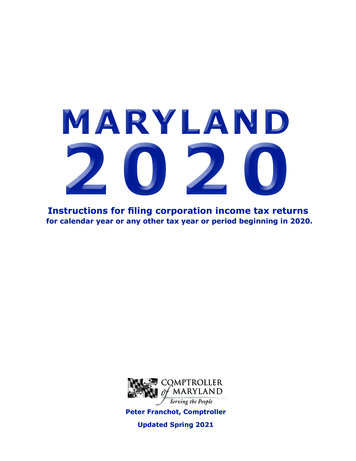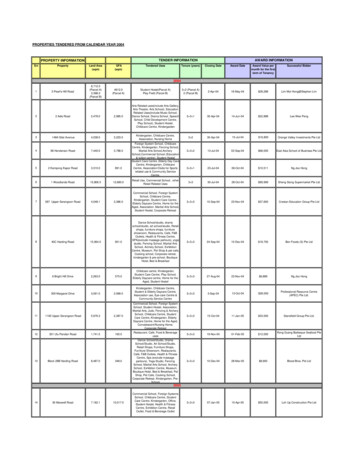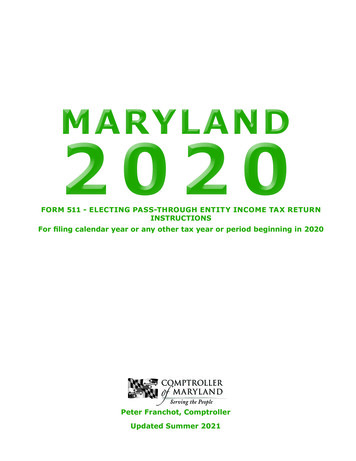
Transcription
MARYLAND2020FORM 511 - ELECTING PASS-THROUGH ENTITY INCOME TAX RETURNINSTRUCTIONSFor filing calendar year or any other tax year or period beginning in 2020Peter Franchot, ComptrollerUpdated Summer 2021
Maryland Electing Pass-Through Entity Taxpayers Cybersecurity Incentive Tax Credits**This booklet contains the instructions necessary for a passthrough entity (PTE) that has elected to pay tax at the entitylevel on all members’ distributive or pro-rata shares of income(Electing PTE) to file a 2020 Maryland tax return. Read theinstructions carefully. Electing Pass-Through Entity Member Credit Employer-Provided Long-Term Care Insurance Tax Credit Endow Maryland Tax Credit** Endowments of Maryland Historically Black Colleges andUniversities Tax Credit**Use blue or black ink when completing your forms and checks. Energy Storage Systems Tax Credit**To avoid delays in the processing of your return: do notuse pencil or ink in any other color; do not print returnson colored paper; do not write on, staple or punch holesin the barcode. Enterprise Zone Tax Credit** Film Production Activity Tax Credit** First-Year Leasing Costs Tax Credit for Qualified SmallBusinesses**Form 511 and its related forms are to be used by partnerships, Scorporations, limited liability companies and business trusts thatelect to pay tax on members’ distributive or pro-rata shares ofincome at the entity level. Heritage Structure Rehabilitation Tax Credit from Form502SA business trust shall be classified as a corporation, a partnership,a trust or otherwise, as determined under the United StatesInternal Revenue Code. Job Creation Tax Credit** Maryland Disability Employment Tax Credit** Maryland Employer Security Costs Tax Credit**Senate Bill 523, Acts of 2020: Senate Bill 523 (Acts of2020), added a definition of “pass-through entity’s taxableincome,” required pass-through entities to pay the tax imposedon distributive or pro rata shares of nonresident individual andnonresident entity members, and gave pass-through entities theoption to make an election to pay the tax imposed on distributiveor pro rata shares of income of resident members. Maryland-Mined Coal Tax Credit** More Jobs for Marylanders Tax Credit** One Maryland Economic Development Tax Credit** Oyster Shell Recycling Tax Credit** Preservation and Conservation Easements Tax Credit**Senate Bill 496, Acts of 2021: Also known as the RELIEF Act,Senate Bill 496 (Acts of 2021) created a member addback of thecredit for taxes paid by the Electing PTE. Qualified Farms Tax Credit** Qualified Veteran Employees Tax Credit** Research and Development Tax Credits**Senate Bill 787, Acts of 2021: This legislation defined theElecting PTE’s taxable income as its income under the federalInternal Revenue Code, calculated without regard to anydeduction for taxes based on net income that are imposed byany state or political subdivision of a state, that is derived fromor reasonably attributable to the trade or business of the passthrough entity in this State. Small Business Relief Tax Credit ** Wineries and Vineyards Tax Credit**** Required Certification must be included with Form500CRElectronic Format In accordance with SB 36 of the Acts of2017 of the Maryland General Assembly, the Comptroller ofMaryland may grant a taxpayer a waiver of the requirementto file for certain tax credit(s) by electronic means. Form500CRW, Request for a Waiver, must be submittedwith the Form 500CR that establishes a reasonable causefor not filing by electronic means or that there is no feasiblemeans of filing electronically creating an undue hardship.The Electing PTE's income or loss is taxed at the entity level;distributive or pro rata income or loss is passed through to theseparate members for taxation purposes. If a pass-through entityis owned by a nonresident, and if the entity has not elected to paythe entity-level tax on all members’ distributive or pro rata sharesof income, it may be subject to the nonresident pass-throughentity income tax. If the pass-through entity has not made theelection, it should file Form 510.REMINDER The Maryland Form 511An Electing PTE Income Tax Return must be filed electronicallyif the pass-through entity has generated a business tax creditfrom Form 500CR or a Heritage Structure Rehabilitation TaxCredit from Form 502S to pass on to its members.If a pass-through entity elects to pay the tax on behalf of allmembers, a credit may be claimed on each member's incometax return. Only a non-electing PTE may elect to file a compositereturn on behalf of qualified nonresident individual membersunder which the entity would be the agent to receive any refundor to pay any tax due. Electing PTEs are not permitted to file acomposite return on behalf of any nonresident members. SeeAdministrative Release 6 for more information. You may obtainAdministrative Release 6 by contacting the Comptroller's Office(see Forms and help below).Forms and helpFor online business registration, tax forms, instructions,publications, and Maryland Tax Regulations, visitwww.marylandtaxes.govManufacturing corporations are subject to a special single factorformula of receipts. The rules for calculating this single factor canbe found in Maryland Tax Regulation 03.04.03.10.E-mail your tax questions totaxhelp@marylandtaxes.gov.For assistance, call: 410-260-7980 in Central Maryland or1-800-MDTAXES (638-2937) from elsewhereForm 500CRMaryland Form 500CR is used to claim the following business taxcredits against corporation and individual income tax. Aerospace, Electronics, or Defense Contracts Tax Credit**Filing electronicallyYou may file your Maryland Corporation or Pass-Through Entityreturns electronically using the Modernized e-File methodof Federal/State 1120/1065 filing. For more information,contact our e-File Help Desk at 410-260-7753, by email efil@marylandtaxes.gov or visit www.marylandtaxes.gov Apprentice Employee Tax Credit** Biotechnology Investment Incentive Tax Credit** Businesses That Create New Jobs Tax Credit Clean Energy Incentive Tax Credit** Community Investment Tax Credit** Commuter Tax Crediti
MARYLANDFORM5114GENERAL INSTRUCTIONSFILING FORM 511The Maryland Form 511 must be filed electronically if the passthrough entity has generated a business tax credit from Form500CR or a Heritage Structure Rehabilitation Tax Credit fromForm 502S to pass on to its members.If a federal return is filed or required, a corresponding Marylandreturn must be filed. The form used for filing must reflect thepreprinted tax year in which the Electing PTE’s tax year begins.Use of Federal Figures In preparing Form 511, all items thatare reported for federal purposes must be reported on theMaryland return in the same manner, except where specificallyindicated. The character of an item cannot be changed fromthat required or elected for federal purposes.Taxability The Electing PTE’s income is taxed at the entitylevel; the items of income or loss of the Electing PTE are passedthrough to the members and subject to tax on the members’Maryland income tax return.A LLC is treated as a partnership for Maryland income taxpurposes, unless it is treated as a corporation at the federallevel.The Electing PTE tax does not apply to a member that is a RealEstate Investment Trust (REIT) or to a member that is taxexempt under IRC Sections 408(e) or 501, unless the taxexempt member is subject to the federal income tax on itsfederal return on that share of Electing PTE income. SeeAdministrative Release 6 for other members and certain PTEsthat are considered exempt.A business trust shall be classified as a corporation, apartnership, a trust or otherwise, as shall be determined at thefederal level.Unincorporated pass-through entities should follow the rulesfor partnerships throughout these instructions. Incorporatedpass-through entities should follow the rules for S corporations.Members must report their distributive or pro rata shares ofincome or loss allocable to Maryland on their Maryland incometax return. Such income must be reported in the member’s taxyear in which the Electing PTE’s tax year ends. Credit for taxespaid by the Electing PTE must be claimed on the same return onwhich the member reports the income subject to that tax.The term member is used in these instructions to includepartners of partnerships, shareholders of S corporations,members of LLCs, and beneficiaries of business trusts.WHO MUST FILE?Election to Pay Tax On All Resident and NonresidentMembers’ Distributive or Pro Rata Shares of IncomeEffective July 1, 2020, Electing PTEs may elect to pay tax at theentity level on all members’ distributive or pro rata shares. ForElecting PTEs choosing to pay tax on individual members’shares, the tax is the top marginal state tax of 5.75% plus thelowest local income tax rate of 2.25% of individual member’sdistributive or pro rata share of income. For entity members thetax is 8.25% of resident entity member’s distributive or pro ratashare of income.Entities Required to File Every Maryland PTE must file areturn, even if it has no income or the entity is inactive. ElectingPTEs must file Form 511. Every other PTE that is subject toMaryland income tax law must file Form 510. A PTE that hascredits in Maryland and a PTE that is a member of a PTE that isrequired to file in Maryland must file Form 511 if it is an ElectingPTE, or Form 510 if it is not an Electing PTE.Entities Not Required To FileA multistate PTE that operates in Maryland but is not subject tothe Maryland income tax law is not required to file, although areturn reflecting no income allocable to Maryland may be filedfor record purposes. Letters in lieu of filing will not be accepted.An electing PTE’s taxable income equals the portion of a passthrough entity’s income under the federal Internal RevenueCode, calculated without regard to any deduction for taxesbased on net income that are imposed by any state or politicalsubdivision of a state, that is derived from or reasonablyattributable to the trade or business of the pass-through entity.Qualified Sub-S Subsidiaries are treated as divisions under theIRC and are not considered as separate entities for Marylandpurposes. These divisions will be included on the parentcompany’s annual Maryland return.The amount of tax payable by the Electing PTE may be limitedbased on the distributable cash flow. For additional information,see the instructions for distributable cash flow limitation.Maryland will follow the Internal Revenue Service (IRS) rules forcertain partnerships that do not actively conduct a business thathave elected not to be treated as partnerships. Maryland alsowill follow the IRS rules for a single member LLC that isdisregarded as a separate entity and the income (loss) will beincluded on the member(s) annual Maryland returns.2An Electing PTE is not permitted to file a composite Marylandincome tax return Form 510C on behalf of qualified nonresidentindividual members. Additionally, an Electing PTE with only onemember may not file a composite return. See AdministrativeRelease 6.WHEN AND WHERE TO FILE?Publicly-traded pass-through entities (PTPs) as defined inIRC Section 7704 are exempt from the requirement to pay anonresident tax on behalf of their nonresident members if theyfile Form 510 annually, and report the name, address, taxpayeridentification number (SSN or FEIN) and other informationrequested for each nonresident member whose share of thePTPs' nonresident taxable income exceeds 500 for the taxyear. PTPs supplying the above information are also excludedfrom the definition of nonresident entities. PTPs should not fileForm 511.File Form 511 by the 15th day of the 4th month following theclose of the tax year or period, or as otherwise instructed by theComptroller. The return must be filed with the Comptroller ofMaryland, Revenue Administration Division, 110 CarrollStreet, Annapolis, Maryland 21411-0001.3GENERAL INFORMATION FOR FORM 511Accounting Periods The tax year or period used for thefederal return must be used for the Maryland return. Accordingly,calendar tax years, fiscal tax years, and short tax periods maybe necessary for Maryland filing purposes.Purpose of Form Form 511 is used by an Electing PTE to filean income tax return for a specific tax year or period and toremit Electing PTE tax paid on all members’ distributive or prorata shares of income. The term “pass-through entity” includespartnerships as defined in Internal Revenue Code (IRC) Section761, S corporations as defined in IRC Sections 1361 and 1362,limited liability companies (LLC) as defined in MarylandCorporations and Associations Article, Section 4A-101 andbusiness trusts as defined in Maryland Corporations andAssociations Article, Section 12-101.12020PASS-THROUGH ENTITY ELECTIONINCOME TAX RETURN INSTRUCTIONSSIGNATURES REQUIREDForm 511 must be signed by a duly authorized official of theElecting PTE. Preparers, other than PTE employees, also mustsign the return.These PTPs should enter code number “704” on one of the linesmarked “code number” on the front of Form 510.1
MARYLANDFORM511PASS-THROUGH ENTITY ELECTIONINCOME TAX RETURN INSTRUCTIONS2020S corporations subject to federal corporation income tax,such as for excess net passive income or built-in gains, also aresubject to Maryland corporation income tax. Use Form 500 tocalculate the amount of Maryland corporation income tax.its members a Maryland 510 Schedule K-1 showing the allocableshare of income, additions and subtractions, and/or creditinformation, and tax paid by the Electing PTE on its members'distributive or pro rata shares of income.On the Form 500:Audits and Appeals All items reported on Form 511 aresubject to audit, verification and revision. Returns andamendments are subject to audit and adjustment for a period of3 years from the date the return was due (including extensions)or the date the return was filed, whichever is later.(1) Enter the corporation name, Federal Employer IdentificationNumber and tax year;(2) Enter the total taxable income on line 1, check the applicablebox labeled “Other” and enter “1120S”;In the event of revision and assessment or reduced refund, theComptroller will notify the corporation. If in disagreement withthe assessment or denial of the refund, the corporation may filewith the Compliance Division a written request for revision ofthe assessment or reconsideration of the refund denial. Therequest, in either case, must be made by submitting anapplication for an informal hearing with the Compliance Divisionwithin 30 days of the assessment or denial of the refund.(3) Report additions and subtractions to the extent applicable tothe income subject to federal income tax; and,(4) Complete all other lines as necessary to calculate theamount due (including the lines for modification and/oradjustments to income, apportionment of income andpayments and credits, if appli cable). Attach payment to thefront of Form 500.In addition to filing Form 500 to calculate and pay the corporationincome tax, also file Form 510.5Failure to file a written request or attend the informal hearingwill result in the assessment or denial of refund becoming finaland non-appealable.OTHER MATTERSYou may file an appeal with the Maryland Tax Court within 30days of a final determination by the Compliance Division hearingoffice.Extension of Time to File If unable to file Form 511 by thedue date, the Electing PTE must submit Form 510E – MarylandApplication for Extension to File Pass-Through Entity IncomeTax Return.NOTE: Changes made as part of an amended return aresubject to audit for up to three years from the date theamended return is filed. See Instruction 8 for completing anamended return.The request for extension of time to file will be granted providedthat:Adjustments If the items on the federal return are adjustedby the IRS, a copy of the final IRS adjustment report must besubmitted within 90 days. Copies of the IRS adjustment reportmust be submitted for each member’s income tax return.1) The application is properly filed and submitted by the 15thday of the 4th month following close of the tax year orperiod;2) An application for extension of time has been filed with theIRS; and,Taxpayer Identification Required for Returns and OtherDocuments All returns, correspondence, payments or otherdocuments must indicate the Electing PTE name, FEIN, type oftax and tax year(s) to which the document relates.3) Full payment of any balance due is submitted with theapplication.Properly and timely filed requests for an automatic extension oftime will be granted for seven months for S corporations and sixmonths for other PTEs.All Electing PTEs are required to secure a FEIN from the IRS.The FEIN is the only number used by the IRS for processingpurposes and also is the primary number used by the RevenueAdministration Division.Estimated Income Tax Every Electing PTE that reasonablyexpects Maryland taxable income to develop a tax in excess of 1,000 for the tax year or period must make quarterly estimatedpayments with Form 510D - Declaration of Estimated PassThrough Entity Income Tax. If the Electing PTE is required tomake multiple payments, it will use a Form 510D for each of theadditional payments. This form is available at www.marylandtaxes.gov.The type of tax and tax year(s) are necessary to identify thesubject of the document and the intention of payments. Thisinformation ensures that documents are directed to the correctarea and that payments are applied to the correct account.Use of Paid Preparers The Electing PTE is responsible forthe timely filing of returns, payment of tax, responding torequests and all other requirements, even though a paidpreparer is used.Business Tax Credits To claim or pass on business taxcredits from Form 500CR, the Electing PTE must file Form 511electronically if the Electing PTE has generated a business taxcredit. Form 500CR Instructions are available on our website atwww.marylandtaxes.gov. Business credits are not taken onForm 511, but are allocated to the members of the Electing PTEon Maryland Schedule K-1 (511).Substitute Forms You may file your Maryland income taxreturn on a computer-prepared or computer-generatedsubstitute form provided the form is approved in advance bythe Revenue Administration Division. The fact that a softwarepackage is available for retail purchase does not guaranteethat it has been approved for use.Members then may claim their shares of the Maryland credit.Maryland follows the federal income tax rules as to the allocationof Maryland credits for partners of a partnership (includes LLCand business trust) and for shareholders of an S corporation,unless the terms of the Maryland tax credit permit specialallocation. Allocations of credits at the federal level generallymust be made in accordance with the partners’ respectiveinterests in the partnership at the time the tax credit arises andin accordance with the shareholders’ pro rata shares of the Scorporation’s credits. Form 502S must be included with Form500CR if claiming the Heritage Structure Rehabilitation TaxCredit. You must file Form 511 electronically to claim or pass onany business tax credits.For additional information or to see a list of Approved SoftwareVendors for Maryland Substitute Tax Forms, visit www.marylandtaxes.gov.Employer Withholding of Income Tax Employers thatmake payments to individuals of salaries, wages orcompensation for personal services must withhold an incometax as prescribed in published tables and remit the withholdingsto the Revenue Administration Division with Form MW506 orMW506M – Employer’s Return of Income Tax Withheld.An annual reconciliation is required to be filed on Form MW508– Annual Employer Withholding Reconciliation Return andsubmitted with the state copy of the wage and tax statementsissued to employees as required by law.Statements to Members The Electing PTE should provide to2
For additional information regarding employer withholding tax,address, and phone number, visit www.marylandtaxes.gov.(5) This tax year’s beginning or ending dates are different fromlast year’s because of an acquisition or consolidation. Do notcheck the box for inactive or final if the Electing PTE isinactive in Maryland but active elsewhere.Privacy Notice The Revenue Admin istration Division requeststax return information to administer the income tax laws ofMaryland, including the determination and collection of thecorrect taxes and other amounts. Failure to provide all or partof the requested information may result in the disallowance ofclaimed amounts and an increased tax liability. The law alsomakes provision for securing information from taxpayers thatfail to supply required information, and a penalty may apply.8To correct an error in a previously filed return, complete andsubmit a revised Form 511. Check the “AMENDED RETURN” boxand draw a line through the barcode on the return. A separatepage should be attached containing a detailed explanationof the changes being made, and if the federal return hasbeen amended, a copy of the federal amended form mustbe attached to Form 511. If additional tax was paid with theoriginal return, include the amount paid on line 15a of Form511. The Electing PTE must give a revised statement to themembers advising them of the amendment. Members may alsobe required to file amended income tax returns.Taxpayers have a right to access their tax records maintainedby the Revenue Administration Division, and may inspect,amend or other wise correct them. To obtain a copy, submit awritten request containing the PTE name, address andidentification numbers and specifying the information needed.The request must be signed by an authorized member.As authorized by law, information furnished to the RevenueAdministration Division may be given to the IRS, a properofficial of any state that exchanges tax information withMaryland and to an officer of this State having a right to theinformation in that officer’s capacity. Also, the information maybe obtained in accordance with a proper judicial or legislativeorder.69SPECIFIC INSTRUCTIONSElecting PTE Check Box:Form 511 is used by an Electing PTE to file an income tax returnfor a specific tax year or period and to remit Electing PTE taxpaid on all members’ distributive or pro rata shares of income.You must elect to remit tax on all members' shares of income inorder to use this form. If the PTE is requesting a refund ofestimated payment(s) for tax paid on resident members' sharesof income because the entity has decided not to make the entityelection, use Form 510.TAX YEAR OR PERIODThe tax year is shown at the top of Form 511. The form usedfor filing must reflect the preprinted tax year in which theElecting PTE’s tax year begins. The same tax year or periodused for the federal return must be used for Form 510.Line 1 - Number of members Enter the number of membersthat are individual residents of Maryland (including residentfiduciaries), the number that are individual nonresidents ofMaryland (including nonresident fiduciaries), the number ofnonresident and resident entities, the number of other entities,and the total number of all members.If the tax year of the Electing PTE is other than a calendar year,enter the beginning and ending dates of the fiscal year in thespace provided at the top of Form 511.7AMENDED RETURNSASSEMBLING AND COMPLETING YOUR RETURNInclude in “Others” entities that are tax-exempt under IRCSections 408(e) or 501.Complete the federal income tax return first and use it inpreparation of the Maryland return. Use a minus sign (-) in frontof a number to indicate a negative amount. After completingthe Maryland return, assemble your return in the followingorder: Maryland Pass-Through Entity Form 511 including allForm 511 Schedules B, any required Maryland forms and theirrelated attachments, any K-1 forms showing credits earned bythe Electing PTE and for S corporations a copy of the federalincome tax return through Schedule M2.A single member LLC that is a disregarded entity for federalpurposes is treated as an individual or corporation dependingupon whether the single member is an individual or corporationfor purposes of computing the nonresident tax.Note: In these instructions, the term individual includesfiduciaries, unless specifically excepted.Line 2 - Electing Pass-Through Entity’s taxable income.Enter the Electing PTE’s taxable income under the federalInternal Revenue Code, calculated without regard to anydeduction for taxes based on net income that are imposed byany state or political subdivision of a state, that is derived fromor reasonably attributable to the trade or business of the passthrough entity. An electing PTE’s taxable income is defined forthis purpose as the net amount of income/loss for the PTE, lessinterest from federal obligations plus the amount attributableto taxes based on net income imposed by a state or anypolitical subdivision of a state. The amount attributable totaxes based on net income does not include taxes with a basisother than net income, such as a gross receipts tax or acommercial activity tax.Name, Address and Other InformationType or print the required information in the designated area.Enter the exact Electing PTE name and continue with any“Trading As” (T/A) name if applicable.Enter the FEIN. If a FEIN has not been secured, enter “APPLIEDFOR” followed by the date of application. If a FEIN has not beenapplied for, do so immediately.Enter the date of organization or incorporation and the federalbusiness code number. This date must be expressed numerically,using two digits each for the month, the day and the year. Thefederal business code is a six-digit number available from thefederal return which identifies the principal business activity.Be sure to check the applicable box to indicate the type ofElecting PTE: partnership, s-corporation, limited liabilitycompany or business trust.The taxable income of an Electing PTE that is a partnershipequals the net amounts of lines 1 through 11 of federal Form1065 Schedule K, plus the amount of any federal deductionattributable to taxes based on net income imposed by a state orpolitical subdivision of a state, including but not limited to, taxesbased on net income included on federal Form 1065 Line 14.Check the applicable box if:(1) The name or address has changed;(2) This is the first filing of the Electing PTE;The taxable income of an Electing PTE that is an s-corporationequals the net amount of lines 1 through 10 of federal Form1120S Schedule K, plus the amount of any federal deductionattributable to taxes based on net income imposed by a state(3) This is an inactive Electing PTE (in Maryland and elsewhere);(4) This is the final return of a Electing PTE that has dissolved,liquidated or withdrawn from Maryland; or,3
MARYLANDFORM511PASS-THROUGH ENTITY ELECTIONINCOME TAX RETURN INSTRUCTIONSor political subdivision of a state, including but not limited to,taxes based on net income included on federal Form 1120SLine 12.2020DISTRIBUTABLE CASH FLOW LIMITATION WORKSHEET (11A)(Complete this worksheet only if using the distributable cashflow limitation.)This addition does not include taxes with a basis other than netincome, such as a gross receipts tax, commercial activity tax,or property tax.A.Pass-through entity’s taxable income.(Enter amount from Form 511, line 2.) . . . . . .B.Line A adjusted, in the case of an ElectingPTE using the accrual method of accountingto report the Electing PTE’s taxable income,to reflect the amount of taxable income thatwould have been reported under the cashmethod of accounting (if the Electing PTEis not using the accrual method ofaccounting to report the Electing PTE’staxable income, enter amount fromLine A) . . . . . . . . . . . . . . . . . . . . . . . . . . . .C.Cash receipts for the tax year that are notincludable in the gross income of the ElectingPTE including capital contributions and loanproceeds. (Enter any cash receipts receivedby the Electing PTE that were not includedin gross income including capital contributionsand loan proceeds.). . . . . . . . . . . . . . . . . . . .D.Amounts allowable to the Electing PTE for thetax year as deductions for depreciation,amortization and depletion. (Enter the allowabledepreciation, amortization and/or depletion usedas a deduction from the Electing PTE's taxable income.)E.The decrease, if any, in the Electing PTE’sliability reserve as of the end of the tax year.(If the Electing PTE has established a liability reserve,enter the amount that represents the decrease,if any, in this reserve account. Liability reservemeans accrued unpaid liabilities that are notdeductible in computing taxable income.). . . . .F.Total. (Add lines B through E.) . . . . . . . . . . . .G.Cash expenditures for the tax year that arenot deductible in computing the Electing PTE'staxable income. (Do not include distributionsto members. Enter any cash expenditures thatare not deducted when computing the ElectingPTE's taxable income. Items such asdistributions to members are not included inthis amount.) . . . . . . . . . . . . . . . . . . . . . . . .H.The increase, if any, in the Electing PTE’s liabilityreserve as of the end of the tax year. (Ifthe Electing PTE has established a liabilityreserve, enter the amount that represents theincrease, if any, in this reserve account.Liability reserve means accrued unpaidliabilities that are not deductible in computingtaxable income.). . . . . . . . . . . . . . . . . . . . . .I.Distributable cash flow. (Add lines G andH, and subtract the total from line F.) . . . . . . .Line 8 - Pass-through entity taxable income for entitymembers Multiply line 4 by the percentage on line 5b andenter the result.J.Members’ tax previously paid. (Enter allmembers’ estimated tax paid with Forms510D or 510E.) . . . . . . . . . . . . . . . . . . . . . . .Line 9 - Entity tax Multiply the amount of line 8 by 8.25%.K.Distributable cash flow limitation. (Subtractli
The term member is used in these instructions to include partners of partnerships, shareholders of S corporations, members of LLCs, and beneficiaries of business trusts. 1 WHO MUST FILE? Entities Required to File Every Maryland PTE must file a return, even if it has no income or the entity is inactive. Electing PTEs must file Form 511.
